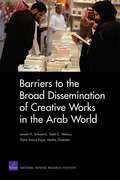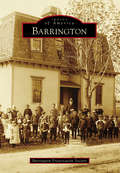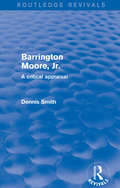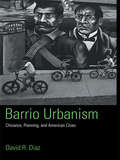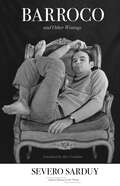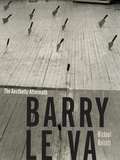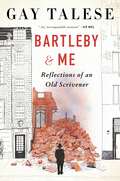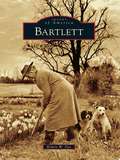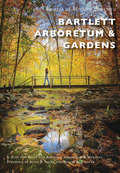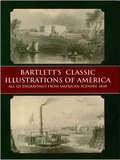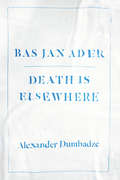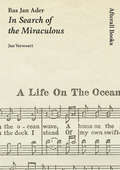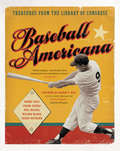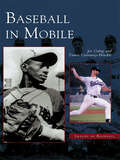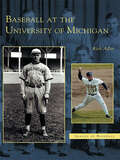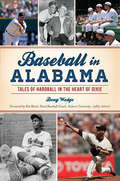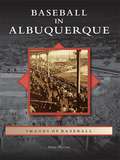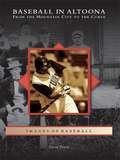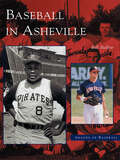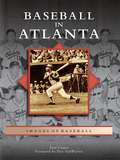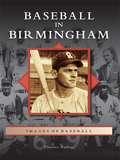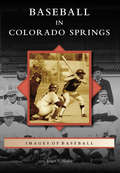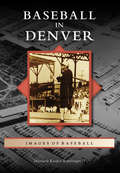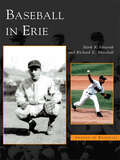- Table View
- List View
Barriers to the Broad Dissemination of Creative Works in the Arab World
by Lowell H. Schwartz Todd C. Helmus Dalia Dassa Kaye Nadia OweidatA growing body of creative works by Arab authors and artists counters the intellectual and ideological underpinnings of violent extremism. Unfortunately, many of these works are not widely disseminated, marginalizing the influence of these alternative voices. This monograph examines the barriers to the broad dissemination of such works, with a focus on Arabic literature, and suggests ways to overcome these barriers.
Barrington (Images of America)
by Barrington Preservation SocietyThe story of Barrington, Rhode Island, began in the 1640s with a small outpost on the shores of Narragansett Bay. Despite its total destruction during King Philip’s War in 1675–1676, by 1717, it was incorporated as a town named Barrington after the brother of the governor of Massachusetts. During the 18th century, Barrington grew into a strong agricultural community. In the 1850s, the brickyard became a full-scale industry, and the new railroad accelerated population growth by attracting people seeking a summer resort and others to work in the brickyard, especially Irish and French Canadian immigrants. At the beginning of the 20th century, the Rhode Island Lace Works brought a new wave of Italian families, yet the town remained primarily an agricultural community, combined with oyster culture. Elegant residences sprang up along the shores of the Barrington River and Narragansett Bay, while Maple Avenue became the center of a large Italian community. After World War II, the population exploded and Barrington became the premier bedroom community of Rhode Island due to an outstanding school system, a remarkable housing stock, and excellent recreational and boating opportunities.
Barrington Moore Jr: A Critical Appraisal
by Dennis SmithThis title was first published in 1983. Throughout this present book author states his objective will be to elicit Moore’s approach to the question he regards as central: how may historical knowledge be used by men and women in order to comprehend and master their destiny within the limits of their moral and rational development and the stage of evolution reached by the societies and the global order to which they belong? This study is divided into four parts. In the first part an account of the text of Social Origins will be followed by, on the one hand, an analysis of the political and intellectual context in which it appeared and, on the other hand, a survey of reviews. In the second part attention will be paid to the development of Moore’s theoretical approach. In the third part the major political and historical studies will be analysed. Soviet Politics and Social Origins will be discussed first. In the fourth part Moore’s approach to historical analysis and political theory will be contrasted with those of a number of his contemporaries. Finally, Moore’s work will be related to the concerns of critical theory and the project of ‘restructuring’ social and political theory espoused by Richard Bernstein.
Barrio Urbanism: Chicanos, Planning and American Cities
by David R. DiazThis, the first book on Latinos in America from an urban planning/policy perspective, covers the last century, and includes a substantial historical overview the subject. The authors trace the movement of Latinos (primarily Chicanos) into American cities from Mexico and then describe the problems facing them in those cities. They then show how the planning profession and developers consistently failed to meet their needs due to both poverty and racism. Attention is also paid to the most pressing concerns in Latino barrios during recent times, including environmental degradation and justice, land use policy, and others. The book closes with a consideration of the issues that will face Latinos as they become the nation's largest minority in the 21st century.
Barroco and Other Writings (Cultural Memory in the Present)
by Severo SarduySevero Sarduy was among the most important figures in twentieth-century Latin American fiction and a major representative of the literary tendency to which he gave the name Neobaroque. While most of Sarduy's literary work is available in English, his theoretical writings have largely remained untranslated. This volume—presenting Sarduy's central theoretical contribution, Barroco (1974), alongside other related works—remedies that oversight. Barroco marks a watershed in postwar thought on the Baroque, both in French post-structuralism and in the Latin American context. Sarduy traces a double history, reading events in the history of science alongside developments in the history of art, architecture, and literature. What emerges is a theory of the Baroque as decentering and displacement, as supplement and excess, a theory capacious enough to account for the old European Baroque as well as its queer, Latin American and global futures. In addition to Barroco, this volume includes texts spanning Sarduy's career, from 1960s essays published originally in Tel Quel to late works from the 1980s and '90s. It thus offers a complete picture of Sarduy's thinking on the Baroque.
Barry Le Va: The Aesthetic Aftermath
by Michael MaizelsOf the conceptual artists who began their careers in the 1960s and 1970s—Bruce Nauman, Chris Burden, Vito Acconci, and Mel Bochner among them—Barry Le Va may be the most elusive. As this first study of his work reveals, his rigorously planned art was instigated to mask its creator&’s intentions and methods, presenting itself as an &“aftermath&” of modernism&’s claim to permanency and civil society&’s preferred mode of monumentalism.For Michael Maizels, Le Va&’s work constitutes a particularly productive subject of inquiry because it clearly articulates the interconnection between the avant-garde&’s distrust of autonomous art objects, two decades of social unrest, the emergence of information theory, and lingering notions of scientific objectivity. Barry Le Va: The Aesthetic Aftermath explores how Le Va used such materials as shattered glass, spent bullets, sound recordings, scattered flour, and meat cleavers embedded in a floor to challenge the interlocking assumptions behind blind faith in lasting beauty, just government, and perfectible knowledge. Taking inspiration from popular crime novels as well as contemporary art theory, Le Va charged his viewers to attempt, like detectives at a crime scene, to decipher an order underlying the apparent chaos.Le Va&’s installations were designed to erode not simply the presumed autonomy of the art object but also the economic and political authority of the art establishment. In his concluding chapter, Maizels looks at the more fixed work of the past two decades in which Le Va turned to architectural themes and cast concrete to probe the limits of dynamism and the idea of permanence.
Bartleby and Me: Reflections of an Old Scrivener
by Gay Talese“Literary Legend” (New York) Gay Talese retraces his pioneering career, marked by his fascination with the world's hidden characters.In the concluding act of this "incomparable" (Air Mail) capstone book, Talese introduces readers to one final unforgettable story: the strange and riveting all new tale of Dr. Nicholas Bartha, who blew up his Manhattan brownstone—and himself—rather than relinquish his claim to the American dream.“New York is a city of things unnoticed,” a young reporter named Gay Talese wrote sixty years ago. He would spend the rest of his legendary career defying that statement by celebrating the people most reporters overlooked, understanding that it was through these minor characters that the epic story of New York and America unfolded. Inspired by Herman Melville’s great short story “Bartleby, the Scrivener,” Talese now revisits the unforgettable “nobodies” he has profiled in his celebrated career—from the New York Times’s anonymous obituary writer to Frank Sinatra’s entourage. In the book’s final act, a remarkable piece of original reporting titled “Dr. Bartha’s Brownstone,” Talese presents a new “Bartleby,” an unknown doctor who made his mark on the city one summer day in 2006. Rising within the city of New York are about one million buildings. These include skyscrapers, apartment buildings, bodegas, schools, churches, and homeless shelters. Also spread through the city are more than 19,000 vacant lots, one of which suddenly appeared some years ago—at 34 East 62nd Street, between Madison and Park Avenues—when the unhappy owner of a brownstone at that address blew it up (with himself in it) rather than sell his cherished nineteenth-century high-stoop Neo-Grecian residence in order to pay the court-ordered sum of $4 million to the woman who had divorced him three years earlier. This man was a physician of sixty-six named Nicholas Bartha. On the morning of July 10, 2006, Dr. Bartha filled his building with gas that he had diverted from a pipe in the basement, and then he set off an explosion that reduced the fivestory premises into a fiery heap that would injure ten firefighters and five passersby and damage the interiors of thirteen apartments that stood to the west of the crumbled brownstone.Talese has been obsessed with Dr. Bartha’s story and spent the last seventeen years examining this single 20 x 100 foot New York City building lot, its serpentine past, and the unexpected triumphs and disasters encountered by its residents and owners—an unlikely cast featuring society wannabes, striving immigrants, Gilded Age powerbrokers, Russian financiers, and even a turncoat during the War of Independence—just as he has been obsessed with similar “nobodies” throughout his career. Concise, elegant, tragic, and whimsical, Bartleby and Me is the valedictory work of a master journalist.
Bartlett (Images of America)
by Robert W. DyeSituated in the geographical center of Shelby County, Bartlett is one of the fastest growing communities in the metro Memphis area. Originally known as Union Depot, Bartlett was chartered in 1866 and was renamed in honor of Gabrial Maston Bartlett. Settlers such as Nicholas Gotten, Samuel Bond, John Blackwell, and Gabrial Bartlett helped to lay the foundation for the city so many call home today. From its early farming days through the Civil War and yellow fever, Bartlett has continued to grow and prosper. Voted the best sports town in Tennessee by Sports Illustrated, Bartlett has seen tremendous growth in recent years, yet it has kept the warmth and feel of a small town.
Bartlett Arboretum & Gardens (Images of Modern America)
by Bartlett Arboretum Gardens Foreword By Smith Hilary B. Forsyth S. Jane TrappBartlett Arboretum & Gardens follows the history of this exquisite Stamford, Connecticut, gem from its genesis as a tree research lab and a training school for arborists to today’s 93 acres of irreplaceable open space. It highlights the best of what Connecticut’s native landscape has to offer: magnificent award-winning champion trees, charming gardens, wildflower meadows, red maple wetlands and boardwalks, woodland walking trails, varied wildlife, and native habitats. As the original home of Francis A. Bartlett, the founder of the F.A. Bartlett Tree Expert Company, the grounds were developed with his favorite trees, including nut trees, small flowering trees, and conifers, from around the world. This is a fascinating story about the passing of the property from Bartlett to the State of Connecticut to the City of Stamford, the hundreds of volunteers who have advocated and toiled to keep the arboretum beautiful and accessible to the public, and the impressive century-old plants.
Bartlett's Classic Illustrations of America: All 121 Engravings from American Scenery, 1840
by W. H. BartlettExtremely rare engravings after illustrations of mid-19th-century America by eminent English artist. Superb, detailed views of Mount Vernon, Saratoga Lake, Faneuil Hall in Boston, Niagara Falls, West Point, The Colonnade of Congress Hall, and much more. All royalty-free. 121 black-and-white illustrations.
Bas Jan Ader: Death is Elsewhere
by Alexander DumbadzeOn July 9, 1975, Dutch-born artist Bas Jan Ader set sail from Chatham, Massachusetts, on a thirteen-foot sailboat. He was bound for Falmouth, England, on the second leg of a three-part piece titled "In Search of the Miraculous. " The damaged boat was found south of the western tip of Ireland nearly a year later. Ader was never seen again. aSince his untimely death, Ader has achieved mythic status in the art world as a figure literally willing to die for his art. Considering the artistOCOs legacy and concise oeuvre beyond the romantic and tragic associations that accompany his peculiar end, Alexander Dumbadze resituates AderOCOs art and life within the conceptual art world of Los Angeles in the early 1970s and offers a nuanced argument about artistic subjectivity that explains AderOCOs tremendous relevance to contemporary art. a"Bas Jan Ader "blends biography, theoretical reflection, and archival research to draw a detailed picture of the world in which AderOCOs work was rooted: a vibrant international art scene populated with peers such as Ger van Elk, William Leavitt, and Allen Ruppersberg. Dumbadze looks closely at AderOCOs engagement with questions of free will and his ultimate success in creating art untainted by mediation. The first in-depth study of this enigmatic conceptual artist, "Bas Jan Ader" is a thoughtful reflection on the necessity of the creative act and its inescapable relation to death. "
Bas Jan Ader: In Search of the Miraculous (Afterall Books)
by Jan VerwoertAn illustrated investigation into the critical motives behind the last, unfinished work that has defined the romantic legacy of conceptual artist Bas Jan Ader. In 1975 Bas Jan Ader disappeared at sea while trying to sail from the East Coast of the United States to Europe as part of a project titled In Search of the Miraculous. Ader's considerable influence on later conceptual artists stems from the way in which he used the cool analytic and antisubjective aesthetics of conceptual art to explore experiences that would seem definitively subjective—the emotional intensity of tragedy and the romantic quest for the sublime. In Search of the Miraculous was conceived as a three-part project: a lonely nighttime walk from the hills of Los Angeles down to the sea, documented in photographs; the Atlantic crossing; a night walk through Amsterdam, mirroring the LA photographs.The circumstances of his disappearance have led many interpreters to identify Ader (as a person) with the role of the tragic romantic hero. The cult status of the artist as a hero whose work is authenticated through his death, however, has obscured the fact that Ader's art was a critical investigation of precisely those romantic motives his persona has now come to be identified with. This book unpicks these ties in Ader's work in order to highlight the specific and unique way in which Ader explores the existential and emotional with an artistic approach that is as conceptual and analytic as it is poetic and personal. Afterall Books are distributed by The MIT Press.
Baseball Americana: Treasures from the Library of Congress
by Frank Ceresi Harry KatzA lavishly illustrated history of America's game from the unparalleled collections of the Library of Congress, with a foreword by George F. Will and a new preface by Carla Hayden, Librarian of Congress“One of the most seductively designed books about the sport to come our way. . . . A book like this, so rich and deep in material. . . . brings baseball history to multifaceted life and reminds us that baseball is the sport that celebrates its history more than any other. . . . This book itself is a form of time-traveling—a pleasurable, often surprising and aesthetic trip.” —San Diego Union-TribuneBaseball, the sport that helped reunify the country in the years after the Civil War, remains the National Pastime. The Library of Congress houses the world's largest baseball collection, documenting the history of the game and providing a unique look at America since the late 1700s. Baseball Americana presents the best of the best from that treasure trove. From baseball's biggest stars to street urchins, from its most newsworthy stories to sandlot and Little League games, the book examines baseball's hardscrabble origins, rich cultural heritage, and uniquely American character.The more than 350 fabulous illustrations—many never before published—feature first-generation, vintage photographic and chromolithographic baseball cards; photographs of famous players and ballparks; and newspaper clippings, cartoons, New Deal photographs, and baseball advertisements. Packed with images that will surprise and thrill even the most expert collector, Baseball Americana is a gift for every baseball fan.
Baseball In Mobile (Images of Baseball)
by Joe Cuhaj Tamra Carraway-HinckleA city wrapped by the Gulf of Mexico's beaches, Mobile has a history as rich as the azalea-saturated soil on which it rests. Recipient of the All-American City distinction, Mobile is home to the original Mardi Gras celebration, the Junior Miss Scholarship Program, the Battleship U.S.S. Alabama, and Hammerin' Hank Aaron. The city's passion for baseball has endured through its tumultuous past, marked by yellow fever, World War II prominence, and the Civil Rights Movement. Spanning from the late 1800s to the present day, Baseball in Mobile recounts the introduction of baseball to the Port City, chronicles the vast talent of Mobile natives who have influenced the sport, and introduces the players and teams of modern Mobile, many of whom are sure to become tomorrow's legends. Historic photographs of the changing baseball landscape are captured in Baseball in Mobile, showcasing the fact that while the fields, uniforms, and teams have changed, the game remains ingrained in Mobile, as constant as the bay that surrounds it.
Baseball at the University of Michigan (Images of Baseball)
by Rich AdlerBaseball at the University of Michigan has had a long and rich tradition. Base ball, to use the contemporary vernacular, began as a club sport during the 1860s. By the dawn of the 20th century, the sport had evolved into the most popular spring leisure event in which students participated. Crowds of greater than 500 were not unusual, at a time when enrollment at the university was approximately 2500 students. Each class and college fielded a team. Prominent names in UM baseball history include the legendary Walker brothers, the first African Americans to play major league baseball, and Branch Rickey, who developed the powerful Dodger teams of the 1940s and integrated baseball with the signing of Jackie Robinson. George Sisler, among the greatest in the National Baseball Hall of Fame, began his career as a Michigan pitcher. And of course there was Ray Fisher, who coached Michigan for 38 years. The end of the century was marked by scandal, but it also brought major league stars such as Hal Morris, Jim Abbot and Barry Larkin, as well as David Parrish and Jake Fox, potential stars of the future.In the shadow of UM football and basketball, baseball is sometimes considered the "other" sport. But in terms of excitement and accessibility to the students, it is still "Number One."
Baseball in Alabama: Tales of Hardball in the Heart of Dixie (Sports)
by Doug Wedge Hal Baird - Head Baseball Coach Auburn University 1985-2000Although football may first spring to mind when talking about sports in Alabama, the state has certainly made its mark with the national pastime. Thirteen players with Alabama roots are enshrined in the National Baseball Hall of Fame, including all-time greats like Hank Aaron, Ozzie Smith and Satchel Paige. Bob Veale of Birmingham led the National League in strikeouts in 1964. Superstars and former players like Bo Jackson and Britt Burns give back to their home state by organizing charities and coaching Alabama's next generation of players. Author and baseball historian Doug Wedge explores stories from this rich history.
Baseball in Albuquerque (Images of Baseball)
by Gary HerronAlbuquerque, New Mexico, is more than a refueling place for motorists on I-40. Professional baseball has been played here for more than 70 years, and fans have had the opportunity to see future Dodgers stars like Don Sutton, Ron Cey, Steve Garvey, Orel Hershiser, Eric Karros, and Mike Piazza hone their skills. Hall of Fame members Tom Lasorda and Duke Snider managed here; Darryl Strawberry, Eddie Murray, and Manny Ramirez have spent short stints "rehabbing" here; and big-league preseason games played in Albuquerque give fans a chance to see non-Dodgers favorites. Albuquerque is also where the Los Angeles Dodgers' triple-A farm team, the Albuquerque Isotopes, played before 600,000 fans in 2009, when the Dodgers "returned" after a nine-year absence. Isotopes Park, a baseball jewel, features great entertainment, a gorgeous view of the majestic Sandia Mountains, and a chance for baseball fans to see major league stars of tomorrow.
Baseball in Altoona: From the Mountain City to the Curve (Images of Baseball)
by Dave FinoliFor 46 days in the spring of 1884, Altoona had the honor of having a major-league baseball team, the Mountain City. For the next 115 years, despite the fact that baseball flourished here in the form of the game that the men of the Pennsylvania Railroad played, professional baseball floundered as six teams came and six teams left. Finally, in 1999, Altoona proved it could support a professional team when the Curve came to town. Since then, an impressive 10 percent of the town's population has shown up at every game, showing the love the community has for the national pastime.
Baseball in Asheville (Images of Baseball)
by Bill BallewBaseball has served as the pastime of preference in Asheville, North Carolina, for more than a century. Nearly anywhere a flat lot can be found in the rolling hills of the Blue Ridge Mountains, baseball has been played by locals and visitors alike, with many of the city's greatest thrills created by the hometown Tourists, who have been mainstays in the professional ranks for most of the past 80 years. Oates Park, where author Thomas Wolfe toiled as a batboy prior to attending the University of North Carolina, served as the home of the Mountaineers, Tourists, and the semi-pro Asheville Royal Giants during the first three decades of the 20th century until McCormick Field was built in the mid-1920s. The ballpark, just south of downtown Asheville, welcomed the likes of Ty Cobb and Babe Ruth during exhibition contests, while future Hall of Famers Eddie Murray and Willie Stargell and current standouts Todd Helton and Juan Pierre honed their skills in the mountains on their way to the game's top level.
Baseball in Atlanta (Images of Baseball)
by Pete Vanwieren Paul CraterBaseball has left a rich legacy on the city of Atlanta, as generations of people have enjoyed the sport as spectators and players in both amateur and professional leagues. In addition to being a source of enjoyment and regional pride, Atlanta's baseball teams have had a huge economic and cultural impact, and their stadiums have altered the face of the city. Baseball in Atlanta explores the sport through 200 rare and vivid photographs from the collections of the Kenan Research Center at the Atlanta History Center.
Baseball in Birmingham (Images of Baseball)
by Clarence WatkinsThe Birmingham Barons were a charter member of the old Southern League in 1885. Built in 1910, Rickwood Field, longtime home of the Barons, is recognized as the oldest surviving, professional baseball park in the nation. The Barons now play at the newly remodeled Regions Park in Hoover, Alabama. In spite of the popularity of football in Alabama, Birmingham continues to be a leader in minor league baseball, winning the prestigious Bob Freitas Award in 2008. This award is given annually by Baseball America to the most outstanding franchise in each classification.
Baseball in Colorado Springs (Images of Baseball)
by Roger P. HadixFrom Boulevard Park and Memorial Field to Security Service Field (formerly Sky Sox Stadium), Colorado Springs is a baseball town. Professional baseball arrived in 1901; the Brown Bombers, a semiprofessional black team, came in the 1940s; and the original Sky Sox won the Western League Championship in 1953, 1955, and 1958. Local players such as Ed Kent, Bill Everitt, Jim Landis, Sam Hairston, Connie Johnson, Vinny Castilla, and Todd Helton have made it to the major leagues. Rich "Goose" Gossage, a Colorado Springs native, went directly from Class A ball to the Chicago White Sox, starting his hall-of-fame career in 1972.
Baseball in Denver (Images of Baseball)
by Matthew Kasper Repplinger IIImages of Baseball: Baseball in Denver shares the city's prominent role in America's great game. The lore of baseball's first pioneers plays out in a real-life soap opera for this Western city. From the early Hall-of-Fame players to the storied baseball-talent barons of Denver's primitive days, baseball has always been on the forefront of the Denver sports horizon. From Tinker to Satchel Paige to "The Babe" himself, the Mile High City has been a barnstormer's oasis in a town that was nothing short of the Wild West. The Denver Post Tournament and the rich history of the Denver Bears are highlighted, as well as the many fields and landmarks throughout the city. With the inception of the Colorado Rockies, Denver once again set the stage for big-league baseball, which many of Denver's local baseball legends have been no stranger to.
Baseball in Detroit: 1886-1968 (Images of America)
by David Lee PorembaCovering over 80 years of America's favorite pastime, Baseball in Detroit 1886-1968 takes fans back to the glory days of Ty Cobb in the early 20th century and follows the progress of the Detroit Tigers. From the three-time pennant winners of this century's first decade to the last real championship team of 1968, Detroiters have flocked to see their team play, win or lose. The fact that they have played at the same intersection of town for over a century is a tribute to the pride and loyalty that each has shown for the other. It could be said that no other baseball franchise has such a close relationship with its constituency. This relationship is clearly shown in a fascinating photographic collection, and sports fans everywhere will appreciate this candid glimpse into our nation's favorite game. As we approach the next millennium, a new stadium is under construction for this historic team. It, too, will be the place of legends, where great players and fans will create another glorious 100 years of baseball history in Detroit. The American League, to which the Detroit Tigers belong as charter members, is fast approaching its own centennial.
Baseball in Erie (Images of Baseball)
by Mark K. Vatavuk Richard E. MarshallErie has had a love affair with professional baseball since the 1880s, though it has been an on-again off-again relationship. Whatever they were called--the Olympics, Blackbirds, Sailors, or SeaWolves--the Flagship City's teams have thrilled fans and won championships. However, many of those local nines faded away, leaving behind memories and empty ballparks. Baseball in Erie is a tribute to the men who brought baseball to this region of Pennsylvania: ambidextrous pitcher Tony Mullane; infielder Louis Bierbauer, the "original" Pittsburgh Pirate; Sam "the Jet" Jethroe; "Turkey" Mike Donlin; Todd Zeile, the record-setting nomadic major-leaguer; and Jose Guillen, the first SeaWolves hero. Through photographs and memorabilia, Baseball in Erie reaches out to fans of the national pastime, especially those who were jammed into the rafters of Ainsworth Field and now bask in the beauty of Jerry Uht Park.
